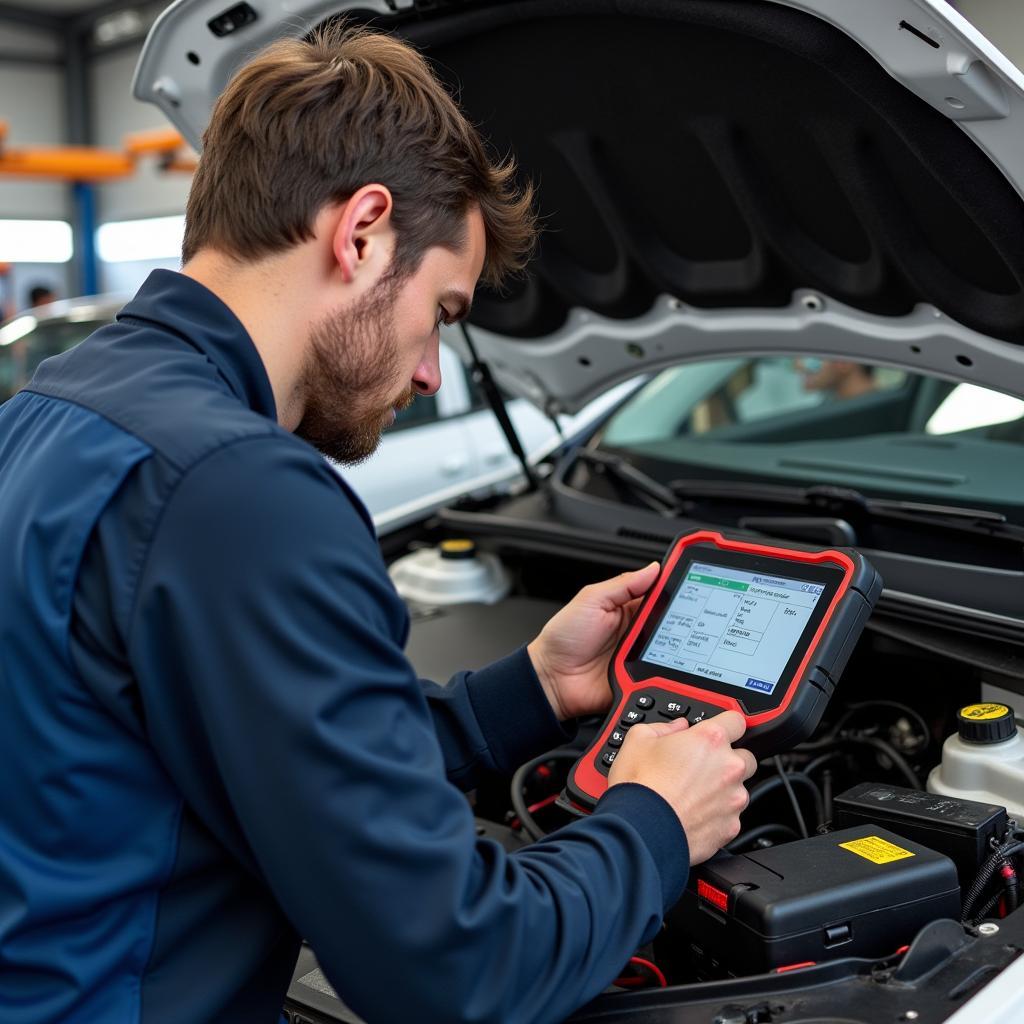Understanding How To Do Car Diagnostic can save you time, money, and frustration in the long run. Whether you’re a DIY enthusiast or simply want to be more informed before heading to the mechanic, this guide will equip you with the knowledge to demystify the world of car diagnostics.
What is Car Diagnostic?
 Car Diagnostic Tools
Car Diagnostic Tools
Car diagnostic is essentially the process of identifying problems within a vehicle’s various systems. This is done by retrieving data from the car’s computer system, also known as the Engine Control Unit (ECU). The ECU acts like the car’s brain, constantly monitoring and adjusting various systems like the engine, transmission, brakes, and emissions.
Why is Car Diagnostic Important?
Imagine this: your check engine light flashes on. Instead of panicking or rushing to a mechanic, wouldn’t it be great to understand what’s going on? That’s where car diagnostic comes in. It helps you:
- Pinpoint Problems: No more guessing games! Car diagnostic tools provide specific error codes that pinpoint the malfunctioning component.
- Save Money: Knowing the exact issue can save you from unnecessary repairs or replacements.
- Prevent Major Issues: Early detection through regular diagnostic checks can prevent minor issues from escalating into major problems.
Types of Car Diagnostic Tools
- Code Readers: These basic tools retrieve and display error codes from the ECU. They are affordable and ideal for DIY enthusiasts.
- OBD2 Scanners: More advanced than code readers, these tools provide live data streams, allowing you to monitor various engine parameters in real-time.
- Professional Diagnostic Scanners: Used by mechanics and dealerships, these comprehensive tools offer advanced features like bi-directional control, programming, and coding capabilities.
How to Perform a Basic Car Diagnostic
While professional-grade tools offer in-depth analysis, you can still perform a basic car diagnostic using an affordable code reader or OBD2 scanner. Here’s a step-by-step guide:
- Locate the OBD2 Port: This standardized 16-pin port is typically located under the dashboard, on the driver’s side.
- Connect the Scanner: Plug the scanner into the OBD2 port.
- Turn on the Ignition: Turn the key to the “on” position without starting the engine.
- Read the Codes: The scanner will retrieve and display any stored error codes.
- Interpret the Codes: Use a reliable online resource or the scanner’s manual to understand what each code means.
- Clear the Codes: After addressing the issue, use the scanner to clear the codes and reset the check engine light.
Common Car Diagnostic Codes
Understanding some common car diagnostic codes can give you a head start:
- P0420: Catalyst System Efficiency Below Threshold (Bank 1)
- P0300: Random/Multiple Cylinder Misfire Detected
- P0171: System Too Lean (Bank 1)
- P0135: O2 Sensor Heater Circuit Malfunction (Bank 1, Sensor 1)
Remember, these codes indicate a potential problem area but don’t necessarily reveal the exact cause. Further investigation is often required.
When to Seek Professional Help
While basic car diagnostic is achievable for many, certain situations warrant professional assistance:
- Complex Issues: If the problem persists after addressing basic codes, a professional mechanic can perform a more in-depth diagnosis.
- Advanced Repairs: Some repairs, like transmission work or airbag system repairs, require specialized knowledge and equipment.
- Safety Concerns: If you suspect a safety-critical system malfunction, it’s crucial to seek professional help immediately.
Tips for Effective Car Diagnostic
- Check for Loose Connections: Before diving into electronic diagnostics, ensure all connections under the hood are secure.
- Consult the Service Manual: Your car’s service manual is a valuable resource for understanding specific error codes and diagnostic procedures.
- Keep a Record: Maintain a log of past diagnostic codes, repairs, and maintenance to track your car’s health over time.
Conclusion
Understanding how to do car diagnostic empowers you to take control of your vehicle’s health. By familiarizing yourself with the basics and utilizing available tools, you can save money, prevent major issues, and become a more informed car owner. Remember, while this guide provides a starting point, seeking professional help is crucial for complex issues or safety-critical repairs.
Want to learn more about specific car diagnostic costs or find reputable places for a full diagnostic check? Visit our website for detailed information.
FAQs
- Can I perform a car diagnostic myself?
Yes, basic car diagnostics can be done using affordable code readers or OBD2 scanners. However, complex issues may require professional help. - What if the check engine light is flashing?
A flashing check engine light usually indicates a more serious problem requiring immediate attention. - How often should I perform a car diagnostic?
It’s a good practice to perform a car diagnostic check at least annually or whenever you notice unusual vehicle behavior.
Car Diagnostic: Common Scenarios and Questions
Scenario 1: My car is shaking while idling. What could be wrong?
This could indicate a problem with your spark plugs, ignition coils, or fuel injectors. A car diagnostic can help pinpoint the exact cause.
Scenario 2: My check engine light is on, but my car seems to be running fine. Should I be concerned?
Yes, even if your car seems to be running normally, a check engine light warrants investigation. It could be a minor issue now, but ignoring it could lead to more significant problems later.
For more information on car diagnostics, check out these helpful resources on DiagFixPro:
Need expert advice or assistance with your car’s diagnostics? Contact our team 24/7 via WhatsApp: +1(641)206-8880 or Email: [email protected]. We’re here to help!

Leave a Reply